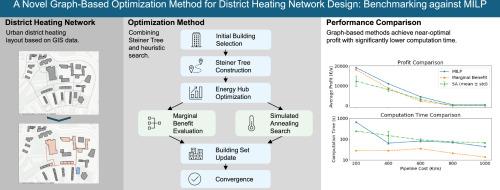区域供热网络设计中一种新的基于图的优化方法:基于MILP的基准
IF 7.1
2区 工程技术
Q1 CONSTRUCTION & BUILDING TECHNOLOGY
引用次数: 0
摘要
在复杂计算规模的城市区域供热网络和能源枢纽优化问题中,混合整数线性规划(MILP)方法可以提供全局最优解,但往往受计算复杂度高和求解时间长的限制。本文提出了一种新的基于图的优化框架,将斯坦纳树公式与两种启发式方法相结合:一种基于边际效益的方法,根据建筑物对网络效率的贡献迭代选择建筑物,以及一种使用模拟退火(SA)探索建筑物组合的元启发式方法。通过将问题分解为供热网络生成和能源枢纽优化,所提出的框架显著降低了计算成本,同时保持了可接受的解决方案质量。MILP和基于图的方法都与地理信息系统数据相结合,以结合现实的地理约束。对比实验表明,在将计算时间从656秒减少到28秒的同时,最佳边际效益解与MILP基准的偏差仅为5%。该方法的平均计算时间为248s,误差为19%。值得注意的是,在空间或时间复杂性增加的情况下,MILP可能在计算上变得难以处理,所提出的启发式方法仍然适用,强调了它们的鲁棒性和大规模区域供热网络规划的实际潜力。虽然有希望,但根据空间布局和需求分布,启发式方法在其他城市环境中的表现可能会有所不同,并且鼓励在不同情况下进一步验证。本文章由计算机程序翻译,如有差异,请以英文原文为准。

A novel graph-based optimization method for district heating network design: Benchmarking against MILP
In the optimization of urban district heating networks and energy hubs with complex computational scales, Mixed-Integer Linear Programming (MILP) methods can provide globally optimal solutions but are often constrained by high computational complexity and long solution times. This paper proposes a novel graph-based optimization framework, combining Steiner Tree formulations with two heuristic approaches: a marginal benefit-based method that iteratively selects buildings according to their contribution to network efficiency, and a metaheuristic method using Simulated Annealing (SA) to explore building combinations. By decomposing the problem into heating network generation and energy hub optimization, the proposed framework significantly reduces computational costs while maintaining acceptable solution quality. Both MILP and graph-based methods are integrated with geographic information system data to incorporate realistic geographical constraints. Comparative experiments show that the best marginal benefit solution deviates by only 5 % from the MILP benchmark while reducing computation time from 656 s to 28 s. The SA method achieves a 19 % deviation with an average computation time of 248 s. Notably, in scenarios with increased spatial or temporal complexity, where MILP may become computationally intractable, the proposed heuristics remain applicable, underscoring their robustness and practical potential for large-scale district heating network planning. While promising, the performance of the heuristics may vary in other urban contexts, depending on the spatial layout and demand distribution, and further validation across diverse cases is encouraged.
求助全文
通过发布文献求助,成功后即可免费获取论文全文。
去求助
来源期刊

Energy and Buildings
工程技术-工程:土木
CiteScore
12.70
自引率
11.90%
发文量
863
审稿时长
38 days
期刊介绍:
An international journal devoted to investigations of energy use and efficiency in buildings
Energy and Buildings is an international journal publishing articles with explicit links to energy use in buildings. The aim is to present new research results, and new proven practice aimed at reducing the energy needs of a building and improving indoor environment quality.
 求助内容:
求助内容: 应助结果提醒方式:
应助结果提醒方式:


